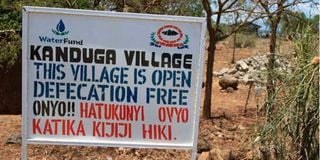Mmmh, it’s a public poop problem: Let’s work to stop open defecation

In Kanduga village, Tharaka-Nithi County, this is an open defecation free zone. Open defecation can pollute the environment and cause health problems and diseases.
What you need to know:
- The journey to realising reasonable standards of sanitation, dates back to 2012 when an ambitious campaign to end open defecation within one year was launched.
- However, by 2013, it was evident that the campaign had not achieved the desired results.
It’s unfortunate that Kenya, a middle-income economy, continues to engage in a conversation about open defecation in the 21st Century. It’s more disturbing that to date, only Busia, Kitui and Siaya counties have achieved Open Defecation Free (ODF) status.
The right to reasonable standards of sanitation was inked in the new constitution under Article 43(b). However, in practice, the implementation is painfully slow. Counties are on the spot for inadequate or non-existent budgets for sanitation and hygiene programs.
Inadequate knowledge on the importance of using a latrine among communities, nomadic lifestyles, cultural issues, topographic challenges in sinking a pit latrine are partly to blame for the current state of affairs. In urban areas, existence of street families with limited access to latrines, rise in informal settlements, and land squabbles remain a major challenge in ending open defecation.
The journey to realising reasonable standards of sanitation, dates back to 2012 when an ambitious campaign to end open defecation within one year was launched.
However, by 2013, it was evident that the campaign had not achieved the desired results. The lessons from the unsuccessful campaign triggered a review of legislation. There was a new push for community led approach as espoused in the 2016 community led total sanitation (CLTS) national policy, the Kenya Environmental Sanitation and Hygiene Strategy as well as a prototype bill on sanitation designed for implementation in the 47 counties.
The population census in 2019 reignited a conversation on the elusive target. A total of 15 counties were isolated as being responsible for 85 per cent of open defecation, meaning that over four million people were still excreting in bushes and open spaces. It further revealed that one in four people in 12 counties practice open defecation.
Sanitation and hygiene
Turkana was listed as leading in open defecation alongside Mandera, Garissa, Kilifi, Baringo, Samburu and Tana River. At the same time, 11 counties had between 20,000 to 120,000 people practicing open defecation, while 18 were reported to have minimal cases of open defecation.
This begged the questions, what lessons could the 44 counties grappling with open defecation emulate to tip the scale? What strategies can they adopt to exit the list of shame and permanently end the conversation on open defecation?
The annual National Sanitation Week under the theme ‘Good leadership in sanitation and hygiene is key to ending open defecation’ , was marked from August 9. The activities were designed to rally communities to end open defecation, focus on a clean environment and challenge county governments to prioritize sanitation and hygiene by allocating funds.
Whereas this was realised over the week, there is the need for a shift in the mindset to meet the 2025 ODF country target. Counties must follow the footsteps of those who succeeded where they failed.
Kitui, considered one of the largest counties with a population of 1.13 million people as per the 2019 census offers good lessons. The county succeeded in ending open defecation three years ago. Its strategy was simple; create fear, show open disgust and shame those who practiced open defecation.
The county also allocated funds towards sanitation programs between 2013-2017 that included sensitization of school children and teachers. The program also incorporated government administration officers, village elders and dedicated Community Health Volunteers (CHV’s) in community led activities, as well as discouraged dependency syndrome in construction of latrines.
Poor sanitation
It was a similar script in Siaya. With a population of 993,183, Siaya people embraced the use of ‘community rovers’. Their job was to conduct random checks and shame those practicing open defecation.
In addition, they introduced a Rapid Results Initiative (RRI) program, a non-monetary reward system. This ensured constant follow-ups, engaged role models, organised review and stakeholder’s meetings as well as dismantled cultural barriers by offering alternatives. One such barrier was to advise the community to construct two doors for one toilet. One door was reserved for use by the parents and the second door was for the children.
Siaya also embraced a campaign dubbed “Bora Choo” which means “at least a toilet” to fast-track compliance. This campaign mutated to “Choo Bora” meaning “a quality toilet” to sustain the open defecation free status it enjoys.
Achieving an Open Defecation Free status is not a walk in the park. A village is subjected to a rigorous process. Officers check to ensure no human waste is visible in open spaces, which includes the floor of a latrine. A latrine must have walls for privacy; the aperture should be covered to avoid contamination of food by flies and the floor must be easy to clean.
The next step requires Community Health Volunteers (CHV’s) to inspect and divisional officers then verify the claim. The report is forwarded to the county headquarters and an external team from a neighbouring county invited to certify. Thereafter the Ministry of Health under the WASH hub authenticates the claim and a banner or bill board is mounted to celebrate the Open Defecation Free status.
As the clock ticks towards 2025, there is need for an accelerated campaign. Counties must re-focus on sustainable sanitation solutions. Hygiene and sanitation programs must be institutionalised and funded.
The culture of incentives to construct pit latrines discouraged and communities educated on the link between poor sanitation, health and diseases as well as reminded to report when they achieve an ODF status. It is possible to defeat open defecation.
Dr Kuria is the Director of Public Health, Ministry of Health


